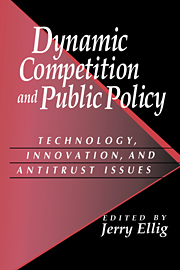Book contents
- Frontmatter
- Contents
- List of Figures and Tables
- Acknowledgments
- List of Contributors
- Introduction
- 1 A Taxonomy of Dynamic Competition Theories
- 2 Competence Explanations of Economic Profits in Strategic Management: Some Policy Implications
- 3 Innovation and Antitrust Enforcement
- 4 New Indicia for Antitrust Analysis in Markets Experiencing Rapid Innovation
- 5 Innovation and Monopoly Leveraging
- 6 Network Effects and the Microsoft Case
- 7 Technological Standards, Innovation, and Essential Facilities: Toward a Schumpeterian Post-Chicago Approach
- 8 Intellectual Property and Antitrust Limitations on Contract
- 9 Conclusion
- Index
9 - Conclusion
Published online by Cambridge University Press: 05 June 2012
- Frontmatter
- Contents
- List of Figures and Tables
- Acknowledgments
- List of Contributors
- Introduction
- 1 A Taxonomy of Dynamic Competition Theories
- 2 Competence Explanations of Economic Profits in Strategic Management: Some Policy Implications
- 3 Innovation and Antitrust Enforcement
- 4 New Indicia for Antitrust Analysis in Markets Experiencing Rapid Innovation
- 5 Innovation and Monopoly Leveraging
- 6 Network Effects and the Microsoft Case
- 7 Technological Standards, Innovation, and Essential Facilities: Toward a Schumpeterian Post-Chicago Approach
- 8 Intellectual Property and Antitrust Limitations on Contract
- 9 Conclusion
- Index
Summary
Dynamic competition research offers a plethora of new insights that could change antitrust policy and antitrust enforcement. However, it is not clear whether consistent application of dynamic insights would lead to greater or less antitrust activity. Some scholars see concepts like path dependence and unique corporate capabilities as additional sources of market imperfections that could be corrected by government action. Others view the potential for entrepreneurial innovation as a sign that monopolistic exploitation carries the seeds of its own demise; monopoly profits create attractive opportunities for alert firms who can dethrone the monopolist. For the former group, dynamic competition is something to be nurtured by careful intervention; for the latter group, dynamic competition means that unhampered markets are even more resilient than previously thought.
Before proceeding from research to policy, it would be helpful to clarify precisely what role dynamic considerations could take in antitrust proceedings. Is dynamic competition simply an additional factor that should be considered, along with more traditional static efficiency, or should analysis of dynamic competition completely displace static considerations? Here are some tentative thoughts on each option.
DYNAMIC COMPETITION AS AN ADDITIONAL FACTOR
If dynamic competition analysis supplements static efficiency analysis, the principal effect might be to create an additional “safe harbor” for firms that appear to have significant market power.
- Type
- Chapter
- Information
- Dynamic Competition and Public PolicyTechnology, Innovation, and Antitrust Issues, pp. 264 - 268Publisher: Cambridge University PressPrint publication year: 2001

